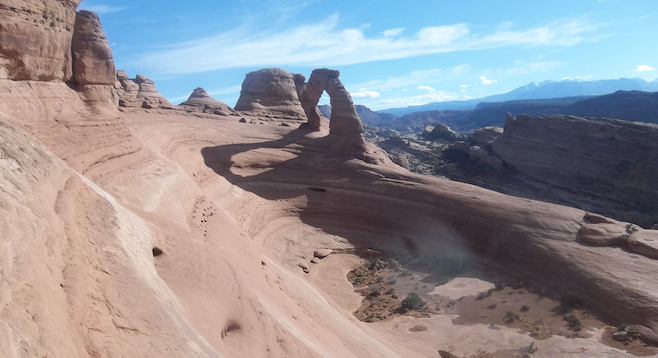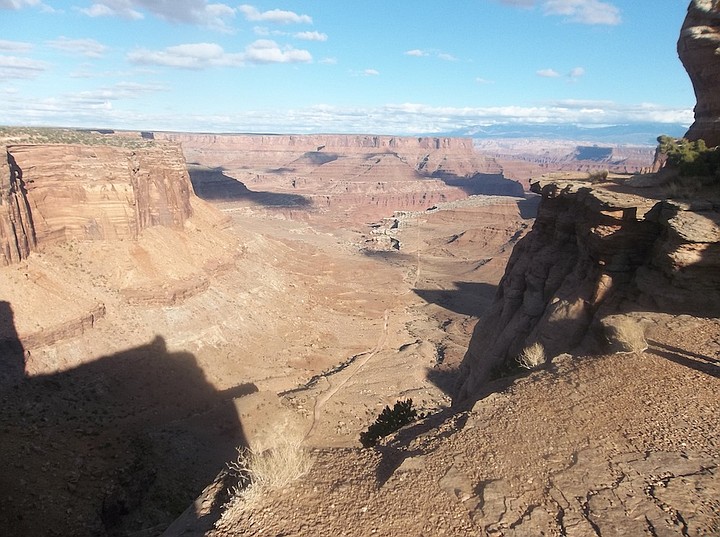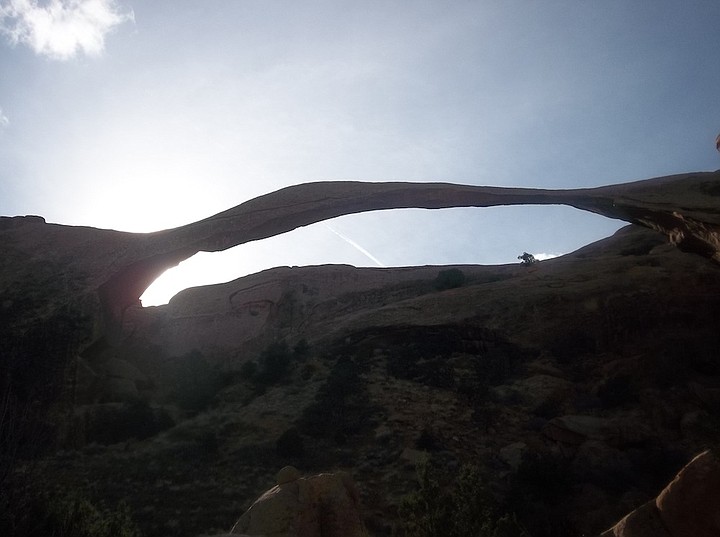 Facebook
Facebook
 X
X
 Instagram
Instagram
 TikTok
TikTok
 Youtube
Youtube

I didn’t see the gorgeous rocks that surround Moab, Utah, when I drove into town on a chilly November evening. My mind was swirling with images of the enormous chasms I had viewed at Canyonlands National Park (below) earlier that afternoon.
I'd arrived an hour before nightfall to survey the impressive canyons. Having driven from Zion earlier that day, I felt fortunate to have made it to one of Moab’s two neighboring national parks as twilight approached.

Canyonlands is a sea of vast canyons and thin spires. Even if you have a limited amount of time, take the Mesa Arch trail and drive the loop to soak in as many vistas as you can. I visited the Island in the Sky section of Canyonlands and was reminded of the Grand Canyon as I stood at dusk gazing at the huge chasms. The play of shadows and late afternoon sun over the canyons was dramatic.
Moab is gateway to not just Canyonlands, but Arches National Park. Together they comprise two of the most gorgeous national parks in the country – and their names provide but a superficial hint of what you will encounter while visiting them.
Arches National Park has an amazing variety of rock structures and over 2,000 sandstone arches. These have evolved from natural forces over millions of years. Natural erosion factors have caused the collapse of some of them, but there are plenty remaining for the visitor to gaze at in wonder.
There are also a variety of hikes to choose from at Arches. There are short hikes, such as the one to Landscape Arch, medium hikes such as to Delicate Arch, and longer hikes like the one further into the Devil’s Garden.
Arguably the best, most scenic hike at Arches – the one that will take you to the “holy grail” of Utah National Park landmarks – is the Delicate Arch Trail. This hike to the iconic arch found on a majority of Utah’s license plates is one of the supreme pleasures that mark this corner of Utah. It can also be a challenge.
At the urging of the ranger at the visitor’s center, I did the walk to Delicate Arch first – a good recommendation if you go in the summer, when the midday heat can become unbearable. It’s a good idea to check the weather conditions before you go and, once there, pace yourself, especially if you’re not an experienced hiker.
Near the start of the walk you can pause to admire some Ute petroglyphs. The hike then gradually ascends up the open face of a rock. Follow the “trailmarkers,” little piles of stones that mark the way. Once you arrive at the arch, there’s a feeling that you’ve achieved something memorable. The small group I encountered up there wanted to linger a bit at the arch and relish in their achievement. People stood in line to have their pictures taken.
Thankfully, the crowd was much smaller than what it usually is. “Normally there are a few hundred people up there,” my Servas host, Drew, informed me.
If you’re not a hiker and prefer to stay in the car while visiting Arches, you can still enjoy your share of gorgeous scenery by driving the 36-mile-long loop around the park. The best rewards, however, come to those who take to the trails.

The hike to Landscape Arch (left) in Devil’s Garden is one of the park’s shortest and easiest. But if you want to more thoroughly explore the Devil’s Garden, a ranger-guided hike is recommended. Devil’s Garden Campground marks the north end of the park’s scenic drive.
A relatively short hike with scenic rewards is to The Windows. Nearby Balanced Rock (you’ll appreciate the name when you see it) is worth pausing to admire. I also particularly enjoyed the Sandstone Arch hike with its striking, Mars-like red sandy canyons. The Fiery Furnace rocks are an amazing tapestry of colors, most notably orange and red, that are particularly striking at sunset.
Moab is a small town of about 6,000 with a lively bohemian vibe. Creative types gather for impromptu poetry reading and musical jams. Drew invited me to his girlfriend’s house for such a jam. We had a long conversation over glasses of wine. She had attended San Diego State University years ago, and recalled her days as a student protesting the Vietnam War during the '60s.
The following night some of the hip, well-traveled, politically and musically aware locals gathered for a jam with some truly unique instruments. “Come on, beat on the frog,” I was urged (or was it a lizard?). The music-making was spirited and fun, but I had the most fun chatting with these folks.
Moab has its share of colorful, controversial and (perhaps) enlightened figures. Weeks earlier, I had been browsing at Barnes & Noble when I became intrigued by a book titled The Man Who Quit Money by Mark Sundeen. Settling into it, I became entranced by this account of a fellow in Moab named Daniel Suelo who lives in a cave and eschews dealing with money as a philosophical experiment. He struck me as something of a modern-day Thoreau. Suelo runs an international blog from the Moab library.
I discovered, upon my arrival in Moab, that Suelo recently house-sat for Drew and borrowed a book about cultural attitudes toward money. Suelo had also attended a party at Drew’s girlfriend’s house the previous week. “He’s a Christ figure,” she extolled. She praised the work he did on her yard and lamented the myth that he’s too lazy to work. He does work in exchange for food and occasional shelter and apparently tries to adhere to the barter system.
Perhaps being in the shadow of such powerful natural formations as those at Arches and Canyonlands National Parks helps fuel the idealistic juices.
There are many other activities in the Moab area other than hiking the parks for those with an outdoors bent. Opportunities abound for mountain biking, rock climbing and whitewater rafting down the Colorado River.


I didn’t see the gorgeous rocks that surround Moab, Utah, when I drove into town on a chilly November evening. My mind was swirling with images of the enormous chasms I had viewed at Canyonlands National Park (below) earlier that afternoon.
I'd arrived an hour before nightfall to survey the impressive canyons. Having driven from Zion earlier that day, I felt fortunate to have made it to one of Moab’s two neighboring national parks as twilight approached.

Canyonlands is a sea of vast canyons and thin spires. Even if you have a limited amount of time, take the Mesa Arch trail and drive the loop to soak in as many vistas as you can. I visited the Island in the Sky section of Canyonlands and was reminded of the Grand Canyon as I stood at dusk gazing at the huge chasms. The play of shadows and late afternoon sun over the canyons was dramatic.
Moab is gateway to not just Canyonlands, but Arches National Park. Together they comprise two of the most gorgeous national parks in the country – and their names provide but a superficial hint of what you will encounter while visiting them.
Arches National Park has an amazing variety of rock structures and over 2,000 sandstone arches. These have evolved from natural forces over millions of years. Natural erosion factors have caused the collapse of some of them, but there are plenty remaining for the visitor to gaze at in wonder.
There are also a variety of hikes to choose from at Arches. There are short hikes, such as the one to Landscape Arch, medium hikes such as to Delicate Arch, and longer hikes like the one further into the Devil’s Garden.
Arguably the best, most scenic hike at Arches – the one that will take you to the “holy grail” of Utah National Park landmarks – is the Delicate Arch Trail. This hike to the iconic arch found on a majority of Utah’s license plates is one of the supreme pleasures that mark this corner of Utah. It can also be a challenge.
At the urging of the ranger at the visitor’s center, I did the walk to Delicate Arch first – a good recommendation if you go in the summer, when the midday heat can become unbearable. It’s a good idea to check the weather conditions before you go and, once there, pace yourself, especially if you’re not an experienced hiker.
Near the start of the walk you can pause to admire some Ute petroglyphs. The hike then gradually ascends up the open face of a rock. Follow the “trailmarkers,” little piles of stones that mark the way. Once you arrive at the arch, there’s a feeling that you’ve achieved something memorable. The small group I encountered up there wanted to linger a bit at the arch and relish in their achievement. People stood in line to have their pictures taken.
Thankfully, the crowd was much smaller than what it usually is. “Normally there are a few hundred people up there,” my Servas host, Drew, informed me.
If you’re not a hiker and prefer to stay in the car while visiting Arches, you can still enjoy your share of gorgeous scenery by driving the 36-mile-long loop around the park. The best rewards, however, come to those who take to the trails.

The hike to Landscape Arch (left) in Devil’s Garden is one of the park’s shortest and easiest. But if you want to more thoroughly explore the Devil’s Garden, a ranger-guided hike is recommended. Devil’s Garden Campground marks the north end of the park’s scenic drive.
A relatively short hike with scenic rewards is to The Windows. Nearby Balanced Rock (you’ll appreciate the name when you see it) is worth pausing to admire. I also particularly enjoyed the Sandstone Arch hike with its striking, Mars-like red sandy canyons. The Fiery Furnace rocks are an amazing tapestry of colors, most notably orange and red, that are particularly striking at sunset.
Moab is a small town of about 6,000 with a lively bohemian vibe. Creative types gather for impromptu poetry reading and musical jams. Drew invited me to his girlfriend’s house for such a jam. We had a long conversation over glasses of wine. She had attended San Diego State University years ago, and recalled her days as a student protesting the Vietnam War during the '60s.
The following night some of the hip, well-traveled, politically and musically aware locals gathered for a jam with some truly unique instruments. “Come on, beat on the frog,” I was urged (or was it a lizard?). The music-making was spirited and fun, but I had the most fun chatting with these folks.
Moab has its share of colorful, controversial and (perhaps) enlightened figures. Weeks earlier, I had been browsing at Barnes & Noble when I became intrigued by a book titled The Man Who Quit Money by Mark Sundeen. Settling into it, I became entranced by this account of a fellow in Moab named Daniel Suelo who lives in a cave and eschews dealing with money as a philosophical experiment. He struck me as something of a modern-day Thoreau. Suelo runs an international blog from the Moab library.
I discovered, upon my arrival in Moab, that Suelo recently house-sat for Drew and borrowed a book about cultural attitudes toward money. Suelo had also attended a party at Drew’s girlfriend’s house the previous week. “He’s a Christ figure,” she extolled. She praised the work he did on her yard and lamented the myth that he’s too lazy to work. He does work in exchange for food and occasional shelter and apparently tries to adhere to the barter system.
Perhaps being in the shadow of such powerful natural formations as those at Arches and Canyonlands National Parks helps fuel the idealistic juices.
There are many other activities in the Moab area other than hiking the parks for those with an outdoors bent. Opportunities abound for mountain biking, rock climbing and whitewater rafting down the Colorado River.
Comments